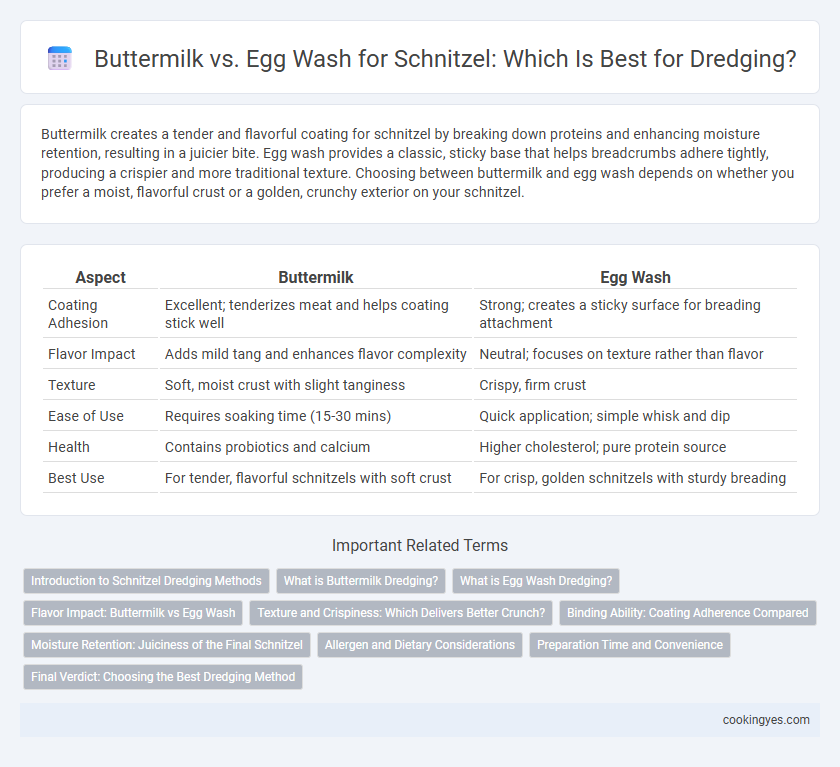Buttermilk creates a tender and flavorful coating for schnitzel by breaking down proteins and enhancing moisture retention, resulting in a juicier bite. Egg wash provides a classic, sticky base that helps breadcrumbs adhere tightly, producing a crispier and more traditional texture. Choosing between buttermilk and egg wash depends on whether you prefer a moist, flavorful crust or a golden, crunchy exterior on your schnitzel.
Table of Comparison
| Aspect | Buttermilk | Egg Wash |
|---|---|---|
| Coating Adhesion | Excellent; tenderizes meat and helps coating stick well | Strong; creates a sticky surface for breading attachment |
| Flavor Impact | Adds mild tang and enhances flavor complexity | Neutral; focuses on texture rather than flavor |
| Texture | Soft, moist crust with slight tanginess | Crispy, firm crust |
| Ease of Use | Requires soaking time (15-30 mins) | Quick application; simple whisk and dip |
| Health | Contains probiotics and calcium | Higher cholesterol; pure protein source |
| Best Use | For tender, flavorful schnitzels with soft crust | For crisp, golden schnitzels with sturdy breading |
Introduction to Schnitzel Dredging Methods
Schnitzel dredging commonly involves either buttermilk or egg wash to achieve a crispy, golden crust. Buttermilk tenderizes the meat and adds a subtle tang, enhancing flavor and moisture retention during frying. Egg wash creates a robust adhesive layer for breadcrumbs, resulting in a crunchy texture essential to traditional schnitzel.
What is Buttermilk Dredging?
Buttermilk dredging for schnitzel involves soaking the meat in tangy, acidic buttermilk before coating it in breadcrumbs, which helps tenderize the meat and enhances moisture retention during frying. This method creates a more flavorful and juicier schnitzel compared to traditional egg wash, as the lactic acid in buttermilk breaks down muscle fibers. The result is a crisp, golden crust with a tender interior, favored in many Southern and European schnitzel recipes.
What is Egg Wash Dredging?
Egg wash dredging involves coating schnitzel with a mixture of beaten eggs, which acts as an adhesive layer for breadcrumbs, creating a crispy and golden crust when fried. This method enhances moisture retention and adds a richer flavor compared to buttermilk, which is thicker and tangier but less adhesive. Using egg wash ensures an even coating, contributing to a classic schnitzel texture prized in traditional German and Austrian cuisine.
Flavor Impact: Buttermilk vs Egg Wash
Buttermilk imparts a tangy, rich flavor that enhances the schnitzel's overall taste profile, while egg wash offers a neutral base that lets the natural meat flavor shine through. The acidity in buttermilk tenderizes the meat slightly, creating a more succulent bite compared to the straightforward coating effect of egg wash. Flavor impact of buttermilk is more pronounced and complex, making it ideal for those seeking a slightly bold, creamy undertone in their schnitzel.
Texture and Crispiness: Which Delivers Better Crunch?
Buttermilk tenderizes schnitzel meat while creating a thicker coating that crisps up beautifully, delivering superior crunch compared to egg wash. Egg wash forms a thinner, more uniform crust that offers a lighter, less textured crispiness but maintains a delicate bite. For maximum texture and crunch, buttermilk provides a richer, crunchier coating ideal for schnitzel frying.
Binding Ability: Coating Adherence Compared
Buttermilk enhances schnitzel coating adherence by tenderizing the meat while creating a slightly thicker, more cohesive base for breadcrumbs to cling to. Egg wash provides a strong binding layer due to its protein content, ensuring a firmer hold on the crust and a crisper texture after frying. Choosing between buttermilk and egg wash depends on desired coating thickness and texture, with buttermilk offering a tenderized interior and egg wash delivering maximum crust adherence.
Moisture Retention: Juiciness of the Final Schnitzel
Buttermilk enhances moisture retention in schnitzel by tenderizing the meat with its mild acidity, resulting in a juicier final product compared to egg wash. The proteins and lactic acid in buttermilk break down muscle fibers, helping the schnitzel retain natural juices during frying. Egg wash mainly provides a binding layer for breadcrumbs but does not significantly improve juiciness or moisture preservation in the schnitzel.
Allergen and Dietary Considerations
Buttermilk contains dairy allergens, making it unsuitable for individuals with lactose intolerance or milk protein allergies, whereas egg wash poses a risk for those with egg allergies. Both ingredients impact dietary restrictions differently: buttermilk is not vegan-friendly, while egg wash excludes strict vegans and individuals avoiding eggs for religious or dietary reasons. Choosing between buttermilk and egg wash for schnitzel dredging requires careful consideration of allergen presence and specific diet needs to ensure safe and inclusive meal preparation.
Preparation Time and Convenience
Buttermilk requires longer marination time, typically 1 to 4 hours, enhancing tenderness before dredging schnitzel, while egg wash provides a quicker, immediate coating. Buttermilk's thicker consistency helps the breading adhere better, reducing the risk of crumbs falling off during frying. Egg wash is more convenient for fast preparation, as it combines easily with seasonings and requires no resting period before breading.
Final Verdict: Choosing the Best Dredging Method
Buttermilk creates a tender, flavorful crust with extra moisture retention, ideal for schnitzel aiming for juiciness and a slight tang. Egg wash delivers a crispier, more traditional golden-brown exterior, enhancing breading adhesion and crunchiness. For the best schnitzel, buttermilk suits those seeking moist texture and taste depth, while egg wash favors classic crispiness and structural integrity.
Buttermilk vs Egg wash for schnitzel dredging Infographic

 cookingyes.com
cookingyes.com